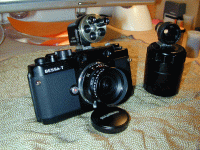Parallax is a strange issue, Earl, and I think sometimes misunderstood. It's the difference between two points of view; the shooter and the film. The only way to have none at all is to view and compose through the lens. The farther apart the two viewpoints, the more the parallax.
This actually can be useful, as the camera rangefinder uses the same principle to measure distance to the subject. But the viewer would like the viewfinder to show as nearly as possible what will be captured on the film. Many viewfinders have moving framelines to show the change in framing as you focus, and some also shrink as you focus closer to indicate the narrower angle of view at close focusing.
The external viewfinders often have indicator marks to show the change of both field size and parallax at the closest focus distance, and you can interpolate between these and the main frameline for intermediate distances. As you focus through one window and frame through another, and keep in mind parallax issues, you need to keep your mind focused on what you're doing. 🙂
One further complication that is a little harder to visualize is that despite the framing and field-size corrections, nothing can change the fact that the viewfinder and film are seeing the subject from slightly different points of view. The corrections are valid only for objects at the focus distance. Objects nearer and farther away will have a slightly different relationship on film than in the viewfinder.
Say you'd like to make a vertical-oriented shot of a nearby person and line up a more distant telephone pole to appear to be growing out of the center of his head. You turn the camera, and the external viewfinder now is to the right of the film. You get the pole centered on his head and take the shot; later viewing the scan or print you see the pole is off to the left. Parallax! If the external viewfinder is positioned directly over the lens centeline, then at least there's no parallax for the horizontal direction, just the vertical. A Leica for instance, with its viewfinder both higher and to the left of the lens, will have two parallax components to compensate for, both horizontal and vertical.
In practice, with the external 40mm viewfinder, just pay attention to the near-subject chop marks for your portrait shots to avoid whacking off your subject's body parts, and out 10m or longer use the full frame and enjoy!


